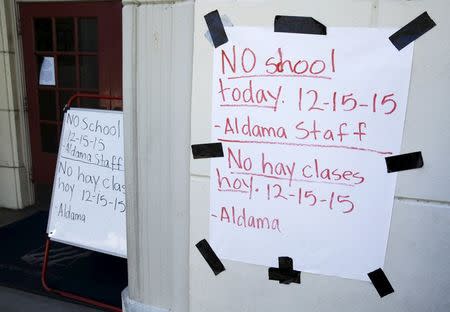At American schools, security fears increasingly prompt evacuations

By Tim Reid LOS ANGELES (Reuters) - While the dramatic closure of the entire Los Angeles school district over a threatened attack grabbed national attention on Tuesday, similar fears are reverberating at schools across the country following a spate of mass shootings and attacks at home and abroad. The shutdown at America's second-largest school district - federal officials said later the threat was likely a hoax - was highly unusual because it involved hundreds of thousands of students. But dozens of other schools have either closed, ordered evacuations or grappled with threats in recent weeks at a time of mounting public anxiety over security. On Monday alone, at least 12 schools dealt with threats significant enough to trigger evacuations or make headlines. Champlain Valley Union High School in Hinesburg, Vermont, for instance, was evacuated on Tuesday after a bomb threat, local news reports said. Authorities did not believe the threat credible but shut the school due to an "abundance of caution." A high school in Beavercreek, Ohio, was evacuated and shut because of a bomb threat on Monday. In Wauwatosa, Wisconsin, a school evacuated students after a bomb threat was made by phone, also on Monday. That prompted a nearby daycare centre to evacuate. Threats to schools are nothing new in America, particularly in early December when many hold half-yearly tests and some students may see a threat as a way to disrupt exams. But the phenomenon appears to be growing, data suggest. There were 812 violent threats made against U.S. schools in the last six months of 2014, the most recent data available, up 158 percent on the previous year, according to the National School Safety and Security Services (NSSSS), a private consulting firm. Those threats led to the evacuation or closure of schools in 30 percent of the cases, according to the study. Threats were made in 46 states in the six month period. A third of the threats were sent electronically, it said. Ken Trump, president of the NSSSS, divided the senders into two primary groups: local students or miscreants; and online gaming types known as "swatters" who disguise Internet addresses with an aim to trigger mass law enforcement responses, including SWAT teams, at schools. Hence their name. Swatters, he added, have been found to operate from outside the United States. The threat sent electronically that prompted the closing of the Los Angeles school district on Tuesday was linked to an Internet address in Frankfurt, Germany, a spokeswoman for the school district said. However, those who made the threat could have been much closer and masked their location. New York City police chief William Bratton said his city's schools had received an almost identical threat as Los Angeles but it was quickly deemed not credible. New York's schools remained open. Bratton described the move in Los Angeles to close schools as a "significant overreaction". RETHINKING SECURITY The school closures and evacuations coincide with a widening national debate over security, gun control and the threat posed by Islamist militants in the United States and overseas, which has spilt into the 2016 presidential election campaign. Many Americans say they increasingly fear an attack, recent opinion polls suggest. In an NBC News/Wall Street Journal poll released on Sunday, the percentage of Americans saying national security and terrorism are the top priority for the federal government had climbed 19 points since April to 40 percent. That followed a spate of mass shootings, capped by the Dec. 2 spree by a heavily armed couple inspired by Islamic State who killed 14 at an office holiday party in San Bernardino, California. That massacre followed a Nov. 27 shooting that killed three at a Colorado Planned Parenthood clinic, the Nov. 13 attack in Paris by Islamic State militants that killed 130 and an Oct. 1 rampage by a gunman who killed 10 at an Oregon college. President Barack Obama has called for greater gun controls. Some Americans have responded by buying more guns, saying they want better protection, or worrying that any new legislation might close down their freedom to purchase weapons. Some schools are rethinking security. Liberty University, a conservative Christian school in Virginia, told students on Dec. 9 that it would reverse a longstanding policy and permit guns in student dorms. Some high-profile public figures are urging Americans to resist succumbing to fear. Bratton, a former Los Angeles police chief, said on Tuesday the threats are made to instil fear in people and that communities should not succumb to it. Brian Levin, a California State University criminologist, said he could not recall a school district the size of Los Angeles ever shutting because of a threat. But he added that people had to make quick decisions with incomplete information at a time of heightened security tensions and in a city just 60 miles (100 km) from San Bernardino attack. In online forums, some Americans questioned whether the fears were healthy and whether schools were going too far. "If the entire Los Angeles school system can be shut down over an e-mail that mentions bombs and backpacks in the same sentence, we are in big trouble. The terrorists have won. Or, more likely, the kid who didn't study for his final exam has won," a reader identifying himself as Dan Frazier wrote on Tuesday in the comments section of The New York Times website. (Editing by Jason Szep and Frances Kerry)

